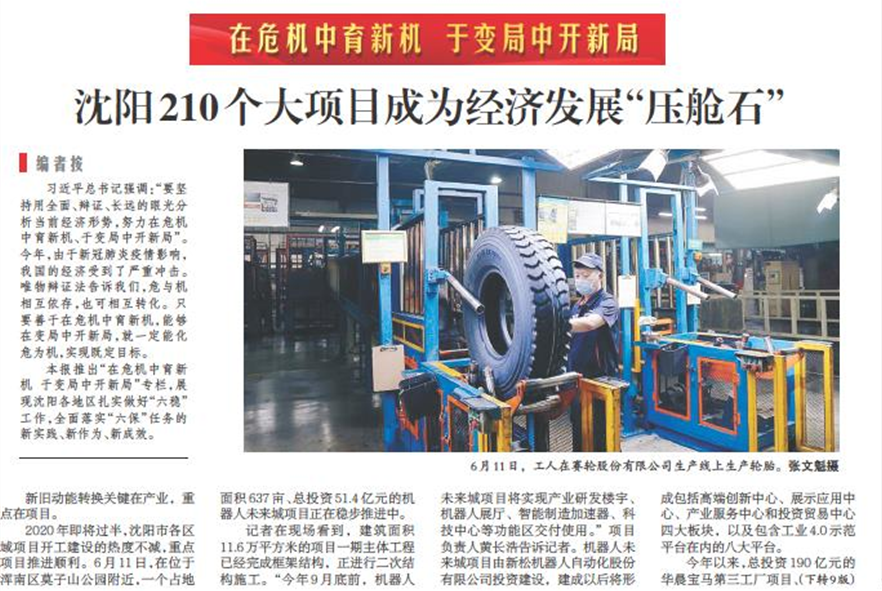
Media reports | 210 major projects in Shenyang become "ballast stones" for economic development
On June 12, the Shenyang Daily newspaper featured an article titled "Cultivating New Opportunities Amidst Crisis, Opening New Situations Amidst Change" in its front-page column, "Shenyang's 210 Major Projects Become Economic Development's Ballast," which highlighted the SIASUN Shenyang Robot Future City project.


The content is as follows:
The key to the transformation of old and new kinetic energy lies in industry, and the focus is on projects.
With 2020 nearing its halfway point, the enthusiasm for project construction in various regions of Shenyang remains high, and the progress of key projects is smooth. On June 11, Located near Mozi Mountain Park in Hunnan District, a 637-mu (approximately 42.47 hectares), 5.14 billion yuan robot future city project is steadily progressing.
On-site, the main structure of the project's Phase 1, with a construction area of 116,000 square meters, has been completed, and secondary structural construction is underway. "By the end of September this year, the Robot Future City project will complete the delivery of functional areas including industrial R&D buildings, a robot exhibition hall, an intelligent manufacturing accelerator, and a technology center," project manager Huang Changhao told reporters. The Robot Future City project is invested and constructed by SIASUN Robot & Automation Co., Ltd. Upon completion, it will form four major sections: a high-end innovation center, a display and application center, an industrial service center, and an investment and trade center, as well as eight platforms, including an Industry 4.0 demonstration platform.
Since the beginning of this year, projects such as the Brilliance BMW Third Factory (total investment of 19 billion yuan), the Shenyang Sanyou Outlets Shopping Plaza (total investment of 2 billion yuan), and the Lin Run Kunyu Mansion (total investment of 2.57 billion yuan) have successively resumed construction.
Currently, the Sailun Tire project (total investment of 3 billion yuan) is undergoing steel structure construction. The Sailun Tire project, invested and constructed by Sailun Group Co., Ltd., China's first A-share listed private tire company, will produce 3 million sets of high-performance intelligent all-steel radial truck tires and high-value-added rubber products annually. It is expected that the project's first tire will officially roll off the production line in November this year, and the project will achieve full production in 2021.
Key projects are the "ballast" of economic development.
Since the beginning of this year, Shenyang has unswervingly implemented the decisions and deployments of the Party Central Committee and the State Council, coordinating the prevention and control of the epidemic and economic and social development, doing a good job in "six stability" work, and implementing "six guarantees" tasks, especially focusing on high-quality development requirements and firmly grasping major project construction.
"The smooth progress of key projects has not only supported steady economic growth but also actively contributed to the accelerated completion of the energy transformation." According to a relevant person in charge of the Municipal Bureau of Industry and Information Technology, in the first five months, key projects in Shenyang have accelerated. Currently, there are 269 manufacturing projects with an investment of over 100 million yuan included in the city's key construction project plan, accounting for 21.9% of the city's 1227 key projects. The total planned investment is 197.26 billion yuan, with a planned investment completion of 22.72 billion yuan this year, including 180 ongoing projects and 89 new projects. As of now, 210 projects have resumed construction, with a resumption rate of 78.1%.
Among the 19 projects included in Shenyang's provincial high-quality development project database, 18 have started construction, with a total planned investment of 91.89 billion yuan and a planned investment completion of 10.3 billion yuan this year.
Shuai Zheng News, Shenyang Daily All-Media Reporter Huang Chao
Shenyang Daily New Media Center (Shenyang.net) Editor Xu Weiwei
Supplementary Information
The Robot Future City project is a major initiative of SIASUN to build an intelligent industrial innovation ecosystem. It focuses on planning eight major industrial platforms: an artificial intelligence incubator platform, a robot incubator platform, a cloud technology intelligent development platform, an industrial intelligent technology platform, an intelligent equipment R&D platform, an Industry 4.0 demonstration platform, an intelligent device R&D platform, and a Zhichuang joint research platform. It plans to build four major industrial development centers: a high-end innovation center, a display and application center, an industrial service center, and an investment and trade center. In the future, it can achieve organic growth of emerging industries such as industrial robots, special robots, service robots, intelligent logistics, wearable devices, and technological finance, promoting the circulation of factors such as technology, capital, and talent, and building a highly developed industrial ecosystem.
SIASUN will continue to firmly grasp the construction of major projects such as the Robot Future City to further enhance the value of robots in industrial manufacturing, logistics distribution, security patrol, and health care. 。 At the same time, closely combining industrial advantages, integrating new technologies, creating new platforms, gaining new energy, achieving new breakthroughs, contributing to epidemic prevention and control, and achieving the goals and tasks of economic and social development this year. "Double Victory" contributes strength.
Shenyang, project, robot, platform, 100 million yuan, industry, construction, center, future, total investment
